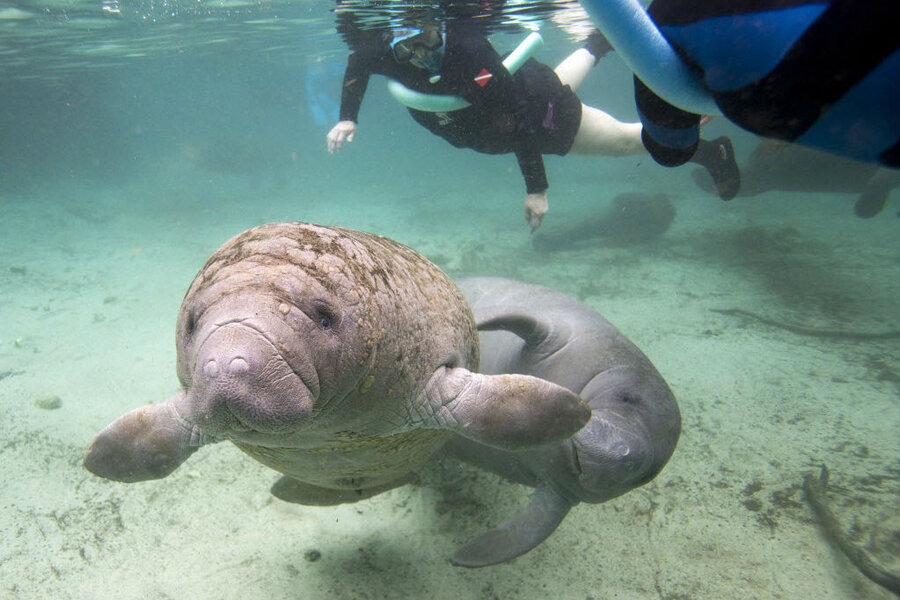Manatee population rebounds: is it ready to come off the endangered species list?
Loading...
The once nearly-extinct manatee has come a long way over the past few decades. The large aquatic mammal was one of the first protected by the federal government in 1967, and efforts from conservation groups and the federal government have helped the creature make a dramatic comeback.
A recent aerial survey of these majestic "sea cows," conducted earlier this month by the Florida Fish and Wildlife Conservation Commission, found at least 6,620 manatees swimming in Florida waters, an all-time high and the third year in a row the count topped 6,000 of the creatures.
The high numbers, say some, are proof that the manatee's status should be raised from "endangered" to "threatened."
But while that seems like a positive step for manatees, some conservationist groups have expressed concerns that it is too soon to downgrade their protections. The Florida manatees, a subspecies of the West Indian Manatee, have been under federal protection for 50 years, and the mammals continue to experience hardships despite – and sometimes even because of – their surging numbers.
"A downlisting reduces the protections offered to a species," Clare Aslan, a community ecologist and conservation biologist at Northern Arizona University, tells The Christian Science Monitor in an email. "For example, there's a low level of 'take' (such as accidental death or injury) that is allowed for a threatened species in the course of management activities, whereas that take (and thus any risky activities) is prohibited for an endangered species. Therefore, for management agencies, there's more flexibility when dealing with a threatened species than there is for an endangered species."
Is the manatee ready for that kind of flexibility?
As the population of manatees grows, so do their fatal interactions with humans, primarily from boat collisions. Most Florida manatees bear propeller scars on their backs, say experts. Of the 520 manatee deaths recorded in 2016, 104 were attributed to boats.
But some conservationists' primary concern is heat sources. In cold weather, manatees tend to huddle near sources of heat like warm springs. When they can't find natural sources of warmth in their shrinking habitat, manatees will seek out other sources, like the warm water flowing from power plants, which do not provide as much protection against cold snaps.
"Ideally you have manatees at all natural sites, which you would have protected for them," Katie Tripp, director of science and conservation for the Save the Manatee Club, told the Miami Herald. "The management community has no control over how Florida makes its power or if there's a cheaper alternative or if the plants shut down.... There's no real reason to think those plants are going to exist forever."
But despite these concerns, manatees have been on the path to "threatened" status since 2007, when the Department of the Interior, which heads the US Fish and Wildlife Service, completed a 5-year status review of the species and recommended reclassifying them. Then, in 2012, the Pacific Legal Foundation petitioned the agency to downlist them.
The Fish and Wildlife Service has known for a decade that the manatee should be reclassified, said Christina Martin of the Pacific Legal Foundation's Palm Beach Gardens office, USA Today reported. "We're happy that the manatee is doing well, and we just want the government to follow the requirements."
The Pacific Legal Foundation's petition kicked off another federal examination, which in January 2016 again recommended downlisting the mammals. The public comment period closed the following April, but the service still has not announced its final decision.
"All comments and information received during the public comment [phase] are given consideration during the status review," Charles Underwood, spokesman for the service's North Florida Ecological Services Office, tells the Monitor via email. "Comments, including those from peer reviewers, are addressed in our forthcoming final decision."
"Should the Service decide reclassification is warranted, the species would remain protected under both the ESA and the Marine Mammal Protection Act," he adds. "Existing protections would not go away, and additional protections could be implemented if needed ... regardless of the species' status on the ESA list."
But some conservationists remain concerned that a shift from "endangered" to "threatened" will lead to a general loosening of restrictions, which could damage a population that is still at significant risk. ASU's Dr. Aslan notes that few species have been downlisted, and most too recently to know how the reclassification affected the population.
"If the population is improving but threats are NOT removed, retaining the 'endangered' status is a way of continuing that improvement," writes Aslan in an email to the Monitor.
"The risk of downlisting is that the rate of mortality may increase as a result of the relaxation of rules," she explains. "If the major threats to a species are still in existence, a downlisted species is likely to need to be re-listed as endangered eventually, and in the meantime population declines could pose a threat of extinction."








